3 METHODS TO KEEP PESKY INSECTS AWAY
You’re sitting on the edge of a mirror-crisp lake, watching the sun come up with a cup of cowboy coffee steaming up your face…when you see a flurry out of the corner of your eye. Then, you hear it. The infernal buzzing that can only mean one thing: bloodsuckers.
Nothing ruins an otherwise peaceful outdoor excursion like the buzzing of mosquitoes in one’s ears. Or spotting a tick making its slow but sure ascent up your pantleg. Or discovering a crop of little red bumps—chiggers—setting up camp on your thigh. You get the idea. We call them pests for a reason. They annoy the hell out of us, but the annoyance is the least of our worries. Most biting insects also carry the risk of disease. Brush up on the three types of insect repellents to bust bugs this summer.
1. AIRBORNE BUG RANGERS
Allethrin
You might not have heard of this one. That’s because it’s the chemical behind the name you probably have heard of: Thermacell. Thermacell devices seem to operate by magic, but what they’re actually doing is deploying a cloud of allethrin vapor into the air, creating a 15-foot-radial “protective zone” for roughly nine hours, to which bugs are not invited.
A synthetic agent of a compound derived from chrysanthemum flowers, allethrin is supposedly safe enough for humans but is still considered mildly toxic. Thermacell makes systems that protect your entire backyard, as well as portable devices and tick repellent tubes.
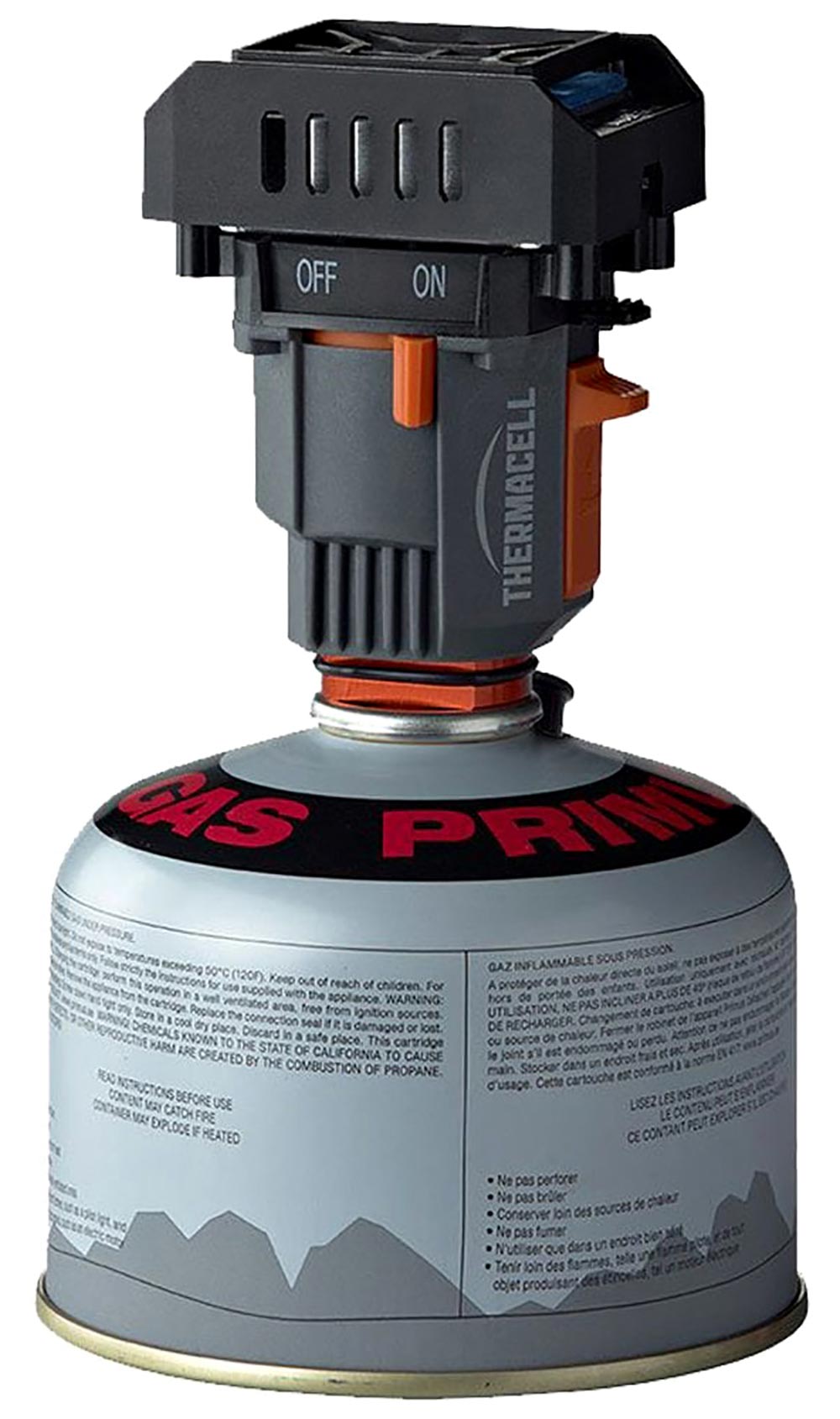

I say use at your own risk. Allethrin does seem highly effective, but it might be overkill for the backyard, when you can choose more natural alternatives like citronella torches, candles, or coils.
Citronella and Oil of Lemon Eucalyptus
Citronella is an oil that occurs naturally in some grasses. The oil works by masking scents that would otherwise draw insects to your flesh, throwing them off target. Oil of lemon eucalyptus often contains citronella in its botanical makeup, so for the sake of ease, I will lump them together.
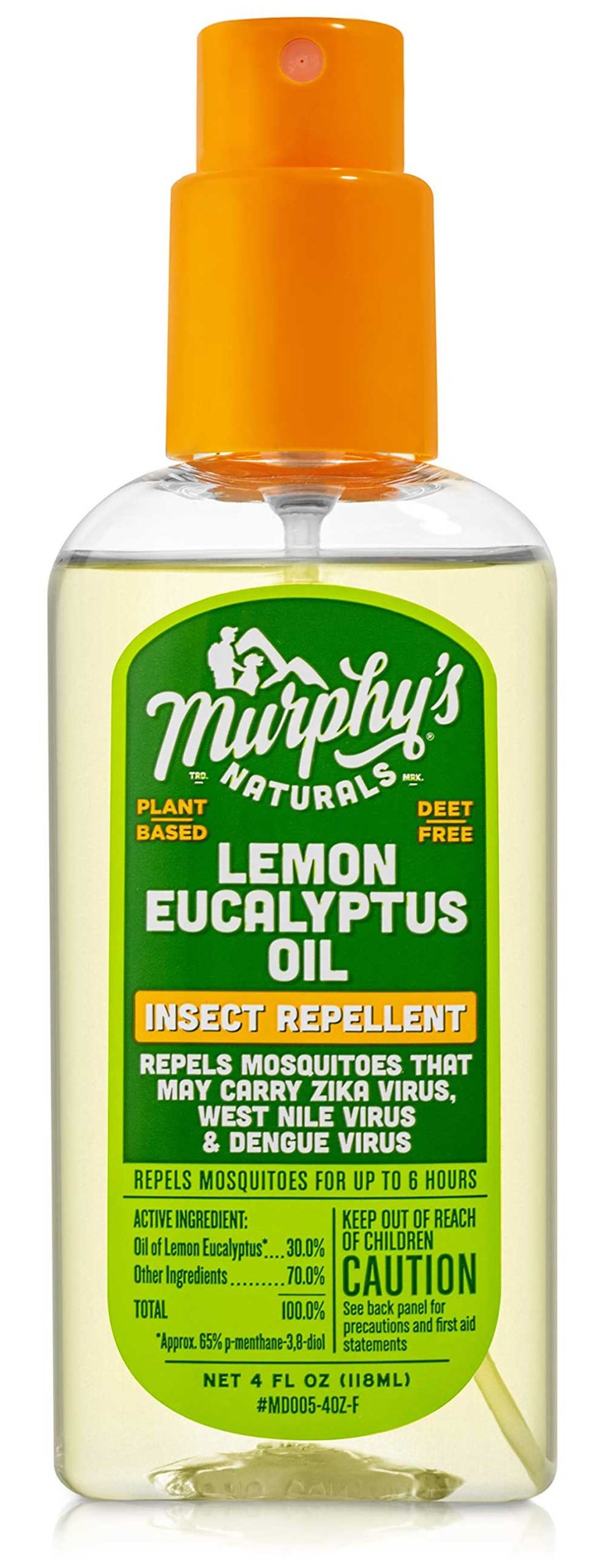
The best things about citronella/oil of lemon eucalyptus and other essential oils, such as geranium and cedar wood, is that they are natural and sourced more sustainably than the gnarlier ingredients in commercial repellents. It’s also handy to just light a candle in the midst of your barbecue and let ’er rip, rather than having to apply topicals (especially to young children).
However, these candles or coils usually last only a few hours, and if you’re using an essential oil spray out in the backcountry, it may not be enough to deter aggressive biters.
Citronella is one of the friendlier insect repellents, both environmentally and health-wise, but it’s not always enough, and oil of lemon eucalyptus shouldn’t be used on children under three. When the situation isn’t dire, choose citronella candles or torch fuel for your backyard, or hang a classy incense coil.
2. TOPICAL TACTICS
DEET
Originally developed for the U.S. Army in 1946, DEET has become a dirty word and not without reason. Though manufacturers and even the EPA, to some degree, claim DEET is safe for humans, there is a long list of precautions and advice on how to use it properly, which indicates it’s not to be trifled with.
You don’t have to search hard online to find articles on the questionability of its safety; even the National Health Institute’s (NIH) own National Library of Medicine has papers posted about neurological deficits in adult rats when exposed to DEET long-term.
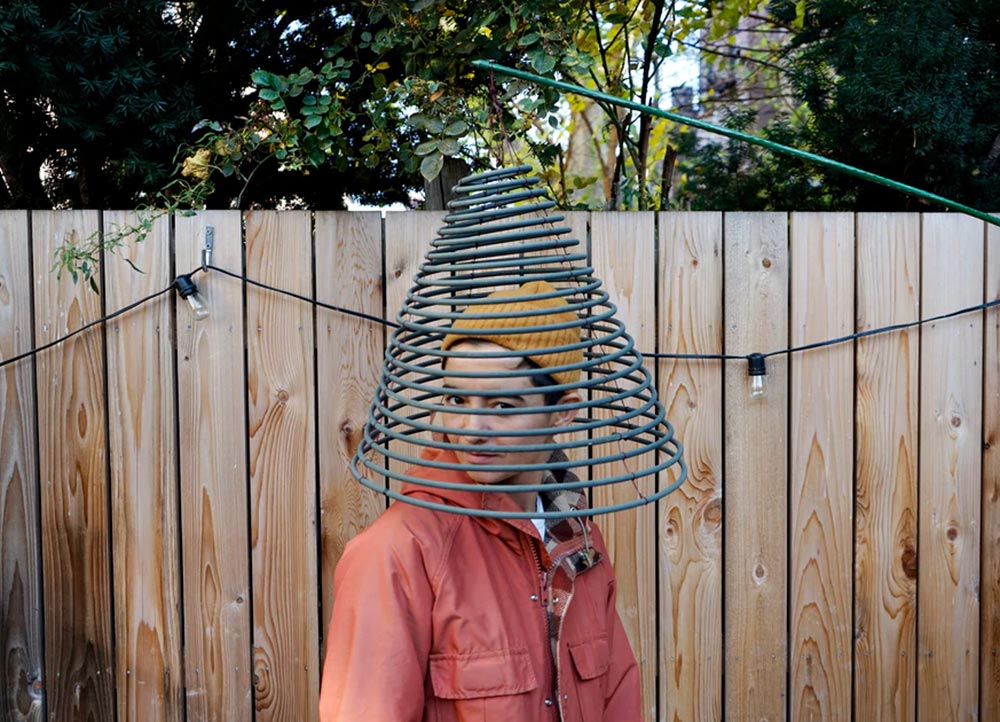
Then why do we use it? Because it works! Let’s face it: there are some scenarios when lesser evils are necessary. Have you fished in Alaska in the summer? There are places on this planet where mosquitoes or ticks are out of control, and bites can be harmful—even deadly. When used strategically and minimally, then washed off skin and clothes once out of harm’s way, DEET-based products may be necessary.
“THE DOWNSIDES OF THESE HIGH CONCENTRATIONS, THOUGH, ARE THAT THE PRODUCT IS SMELLY, GREASY AND CAN EVEN CORRODE SYNTHETIC FABRICS.”
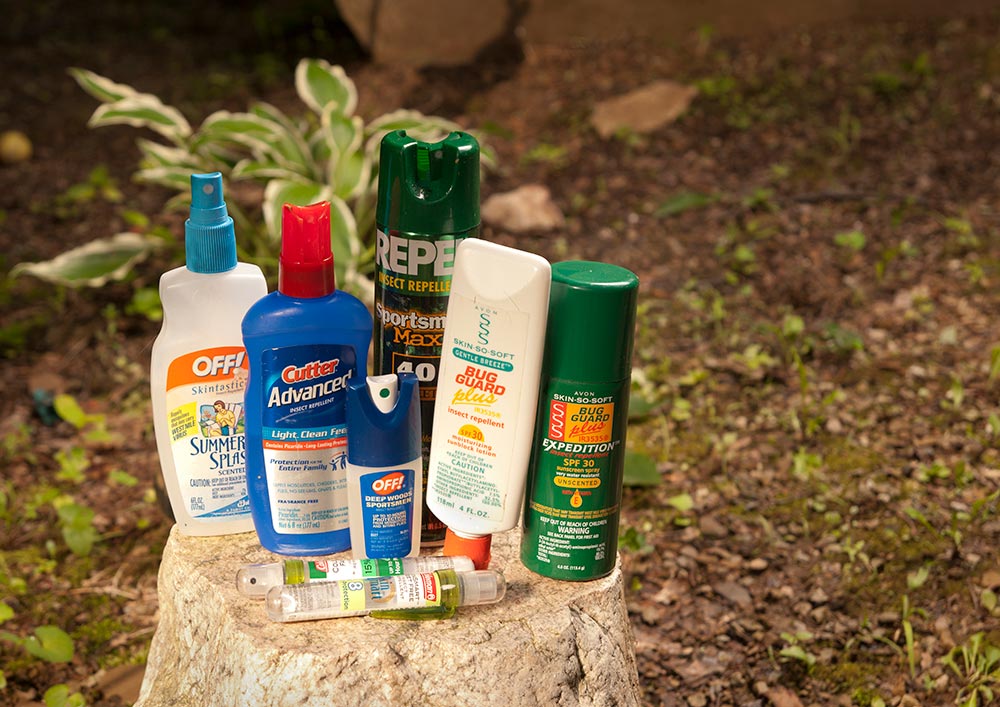
LOKIBAHO / ISTOCK PHOTO
The jury seems to be out on how much DEET is required for adequate protection. There’s somewhat of a consensus on the minimum amount required (this seems to be 30%), but not on how much more you want to add. Some sources say the protection plateaus at 50%, which begs the question: why are there so many products boasting upwards of 98% DEET?
The answer lies somewhere within duration of protection. Supposedly, the more DEET, the longer it lasts (95% lasts up to 10 hours, versus four hours with 30%); however, more doesn’t necessarily protect any better.
The downsides of these high concentrations are that the product is smelly, greasy, and can even corrode synthetic fabrics. In these instances, I shudder to think what it’s doing to your skin…. Don’t be tempted by the higher numbers. Stick to 30%.
IR3535
Developed by Merck & Co., Inc. in the mid-1970s, IR3535 has been used in Europe for over 20 years, though it was only approved for use in the U.S. in 1999. IR3535 is structurally similar to alanine, an amino acid used to make protein.
According to public efficacy studies from 2000 to 2013, it appears to be as or slightly less as effective as DEET and picaridin against mosquitoes, but over twice as effective as those two chemicals and oil of lemon eucalyptus against deer ticks.

Like DEET, IR3535 can dissolve plastics, so I have my doubts. Not about how well it can deter insects but about what it’s going to do to my health. Use at your own risk, but at least avoid the sunscreens that list this as an ingredient. If you’re using sunscreen as recommended (which I also don’t recommend, but that’s another story), you’ll be reapplying every few hours, which would overexpose you to this chemical.
Picaridin
In the 1980s, German scientists were looking for a safer alternative to DEET—you know, something that was safe for skin and wouldn’t make the color slide off your plastic cup and onto your hand. Their efforts resulted in picaridin, a synthetic compound derived from a compound called piperine, which is found in the same plant group as black pepper.
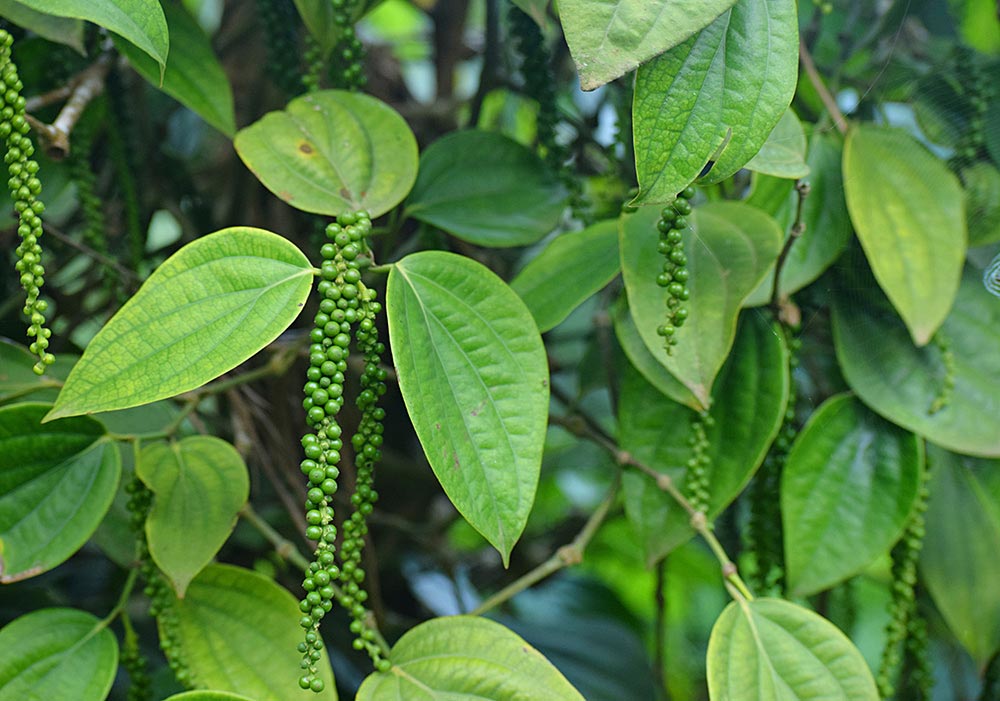
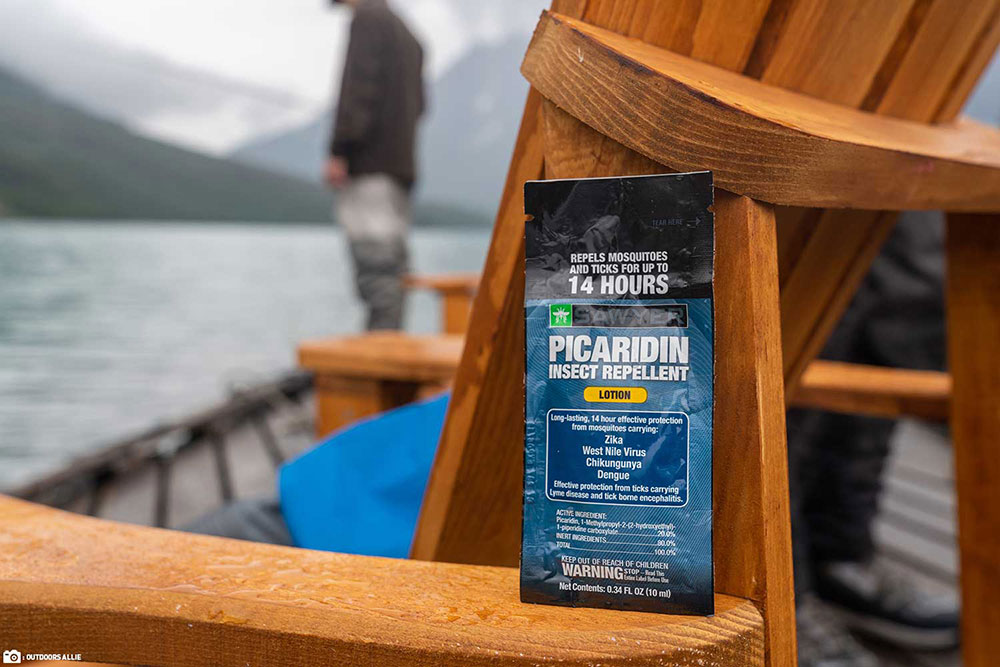
OUTDOORS ALLIE PHOTO
Picaridin has been popular in Europe and Australia since its introduction but didn’t get approved in the U.S. until 2005. While the consensus seems to be that it’s safer and just as effective as DEET, and only requires a minimum of 20% rather than DEET’s 30 for a whopping 12-hour protection, there simply isn’t enough data available to discern its lasting effects on human health.
If you’re more concerned with what it can do for you now, know that it isn’t considered a neurotoxin (like DEET), isn’t corrosive to fabrics, is less smelly, and doesn’t cause the skin irritation that its counterpart sometimes does. These are certainly promising improvements; I’ll give it that.
Permethrin
Developed by a British chemist in 1972, permethrin is different from the other repellents in this list because it’s an insecticide: it actually kills bugs upon contact. A member of the pyrethroid family, this synthetic agent mimics a compound found in chrysanthemum flowers, which fatally damages the nervous systems of insects, dropping them from your person like (yes) flies.
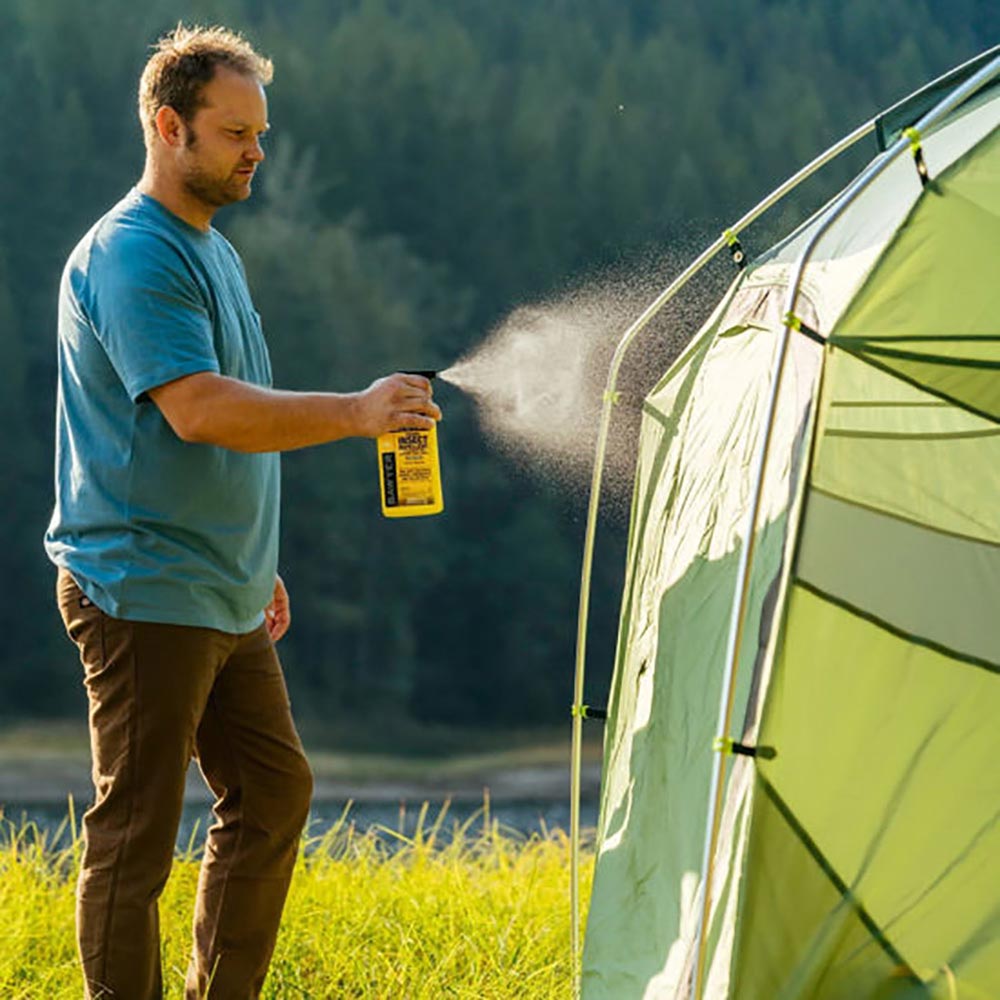
SAWYER PHOTO
Permethrin is a skin irritant, so it usually shows up in sprays used to treat clothing and gear. To use, you’re supposed to go outside and spray it all over your stuff, then let it dry for a few hours (such as with Sawyer’s Permethrin Pump Spray).
Once it’s dry, it’s said to no longer be irritating or toxic, but I have found at least one paper on the damaging effects of both DEET and permethrin on rats in the NIH’s National Library of Medicine, so take that little nugget as you will.
“…EVEN ONE DROP OF PERMETHRIN WILL KILL FISH, SO SPRAY IT FAR FROM ANY PONDS OR AQUARIUMS.”
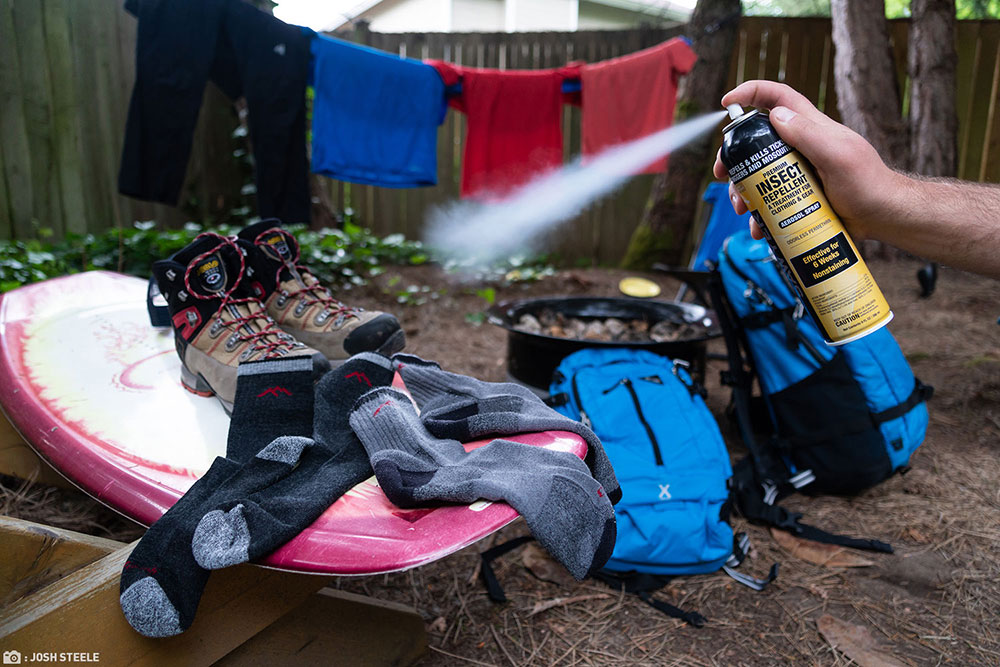
JOSH STEELE PHOTO
Strangely, one manufacturer, Sawyer, claims it’s safe to use the spray on your dog but warns to keep it away from cats. Apparently, wet spray or vapor can be fatally toxic for cats, but…not other animals (or humans)? Additionally, even one drop of permethrin will kill fish, so spray it far from any ponds or aquariums. This seems like a handy tool to have in your arsenal for the backcountry, but proceed with caution, especially around pets.
DIY
Personally, I’m still not sold on what’s on the market for insect repellents. Why? Because they’re on the market! These companies are profiting on humanity’s desire to defend itself against harmful insects.
That’s not to say most companies don’t strive to make the safest, most effective products they can, but as a rule, I don’t typically trust entities out to make a buck when it comes to my health. I can point to many cases of companies and government entities claiming something is safe when it’s anything but.
Sure, you run the risk of homemade concoctions being less effective than the industrial stuff, but most situations don’t call for the big guns.
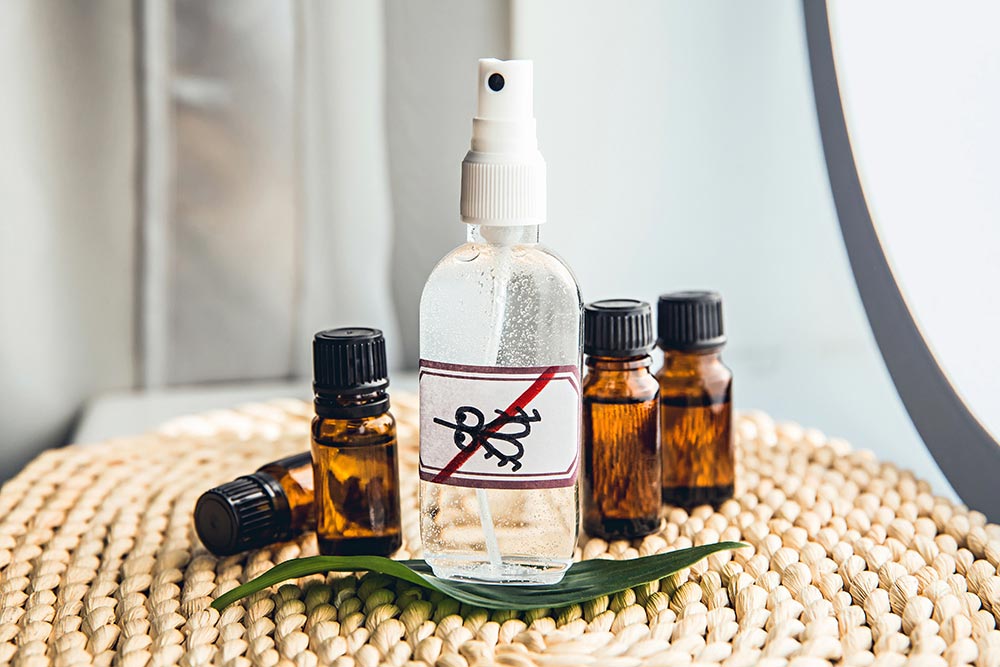
HELINLOIK /DREAMSTIME.COM PHOTO
If you’re like me and want to be as natural as possible, make your own spray. That way you know exactly what’s going into it—none of this 1% citronella, 99% unnamed ingredients. This method will require some trial and error; write down the amounts of what you include in a formula, then tinker with that formula as needed.
When I made my own, I was enticed by the benefits of neem. Neem oil is derived from a plant native to India and is well-known for its antifungal, antiseptic, antipyretic (fever-reducing), and antihistamine properties, but turns out it’s also an effective insect repellent. The downside? For me, it was the smell. In the future, I’ll be spritzing myself with an essential oil that doesn’t smell like onions and body odor.
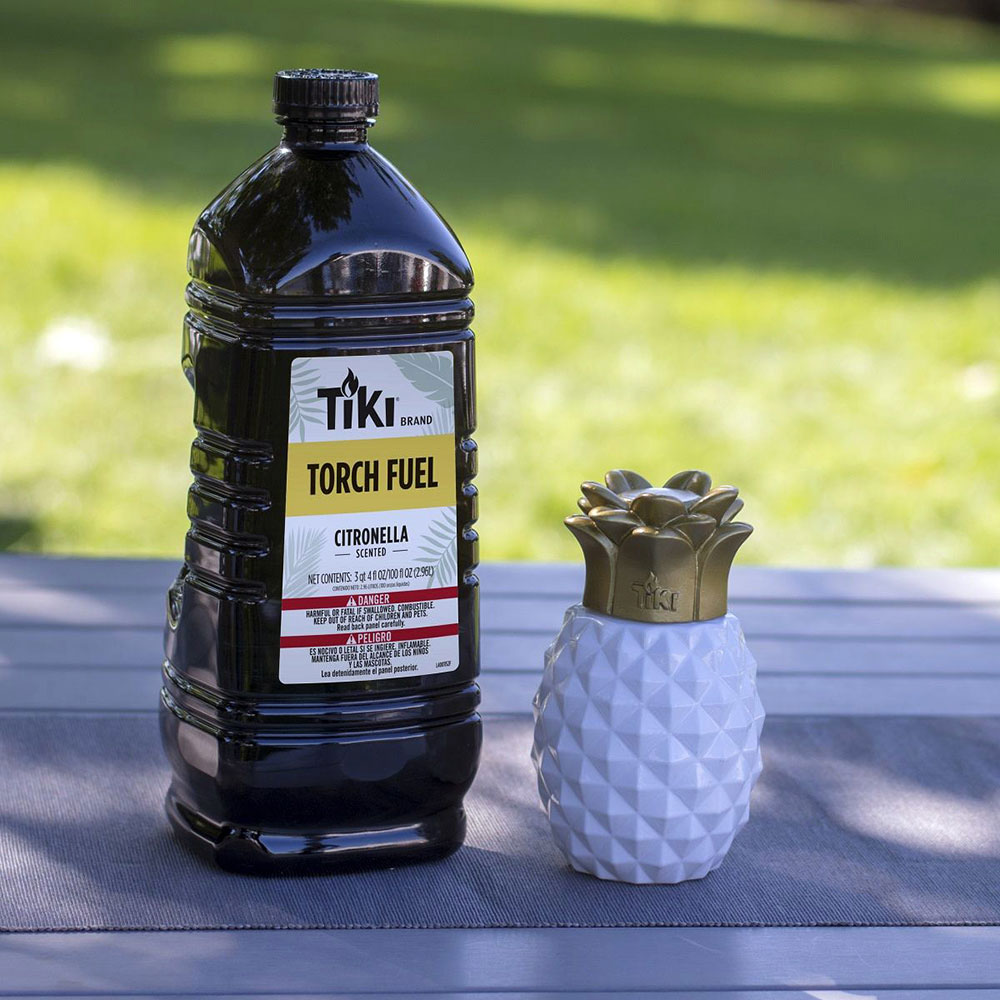
TIKI BRAND PHOTO
If you go the natural route, pair your spray with protective clothing and gear. A wide-brimmed hat and a mosquito head net are just as protective and much safer than any chemicals. If it’s not too hot, wear tightly woven clothing and gloves, preferably in dull colors (male mosquitoes are attracted to bright colors, but this won’t keep females from biting you).
3. COVER UPS
Mesh Nets. I swear by head nets. They may not look sexy…and be overkill for hanging out in your backyard, but they’re a must for hikes in certain areas. Not only do they keep mosquitoes out, they also keep flies and other insects out of your eyes, mouth, and ears.
Pop them over a firm, wide-brimmed hat and draw the elastic closed at your neck and breathe relief—sans chemicals. You can also get entire bug suits, though I’m not sure how well these work, since wherever the mesh comes to rest on your skin still exposes you to probing proboscises (blood-sucking snouts). Tighter mesh weaves exist for midges/no-see-ums, too.

Insecticide-treated Clothing. You’ve no doubt seen clothing with cute names like BugsAway or Insect Shield, usually with a less cute price tag. These articles have been treated with the aforementioned permethrin, with typical claims of protection of up to 60 or 70 washes.
If you don’t want to shell out the dough to replace all your camp clothes and gear with bug-proof versions, you can treat your stuff with diluted permethrin or store-bought pumps. Just be mindful of spraying down your swag near water or pets, and don’t let the wet solution get on you, either.
PLAY IT SAFE WITH DIY
Here’s a tested formula from DIYNatural.com that works well in mild to moderate bug zones. You can get these ingredients anywhere, but make sure they are high quality oils, preferably organic. I get everything from MountainRoseHerbs.com. Swap the oils till you find your signature scent!
What you’ll need:
- 2 Tbsp witch hazel
- 2 Tbsp one or combo of: grapeseed oil, jojoba oil, almond oil, olive oil or neem oil (I like jojoba and almond, though neem is more powerful)
- ½ Tsp vodka
- Small spray bottle (3-4 ounces)
- 100-110 drops of essential oils. I use 55 drops of oil of lemon eucalyptus, 15 drops of cedarwood, 15 drops of Lavendula angustifolia (the proper lavender to use), 15 drops of rosemary. You can also try geranium, peppermint, tea tree, citronella and cinnamon
What you’ll do.
- Add carrier liquids to the spray bottle
- Add essential oils to the spray bottle
- Shake well and apply every few hours (or more, if you get eaten alive like I do), shaking it up before each application
FOR THE LITTLES

You may feel comfortable spritzing yourself with DEET or other chemicals now and again, but how about spritzing your kid? Parents are usually more discerning when it comes to what they’re willing to expose their children to versus themselves.
One company has the safety of kids at the forefront of their mind, and that’s The Natural Patch Co. They make a non-woven fabric patch called a BuzzPatch that’s treated with a blend of citronella and geraniol oils to keep kids bite-free.
Designed and formulated in Australia, these patches stick to clothes rather than skin, smell great, and last six hours. Save unused patches in a Ziploc bag, and they’ll keep for up to six months.
A version of this article first appeared in the July 2022 issue of American Outdoor Guide Boundless.

